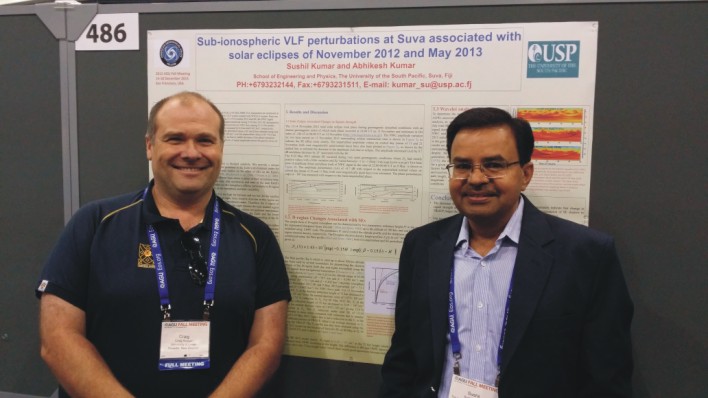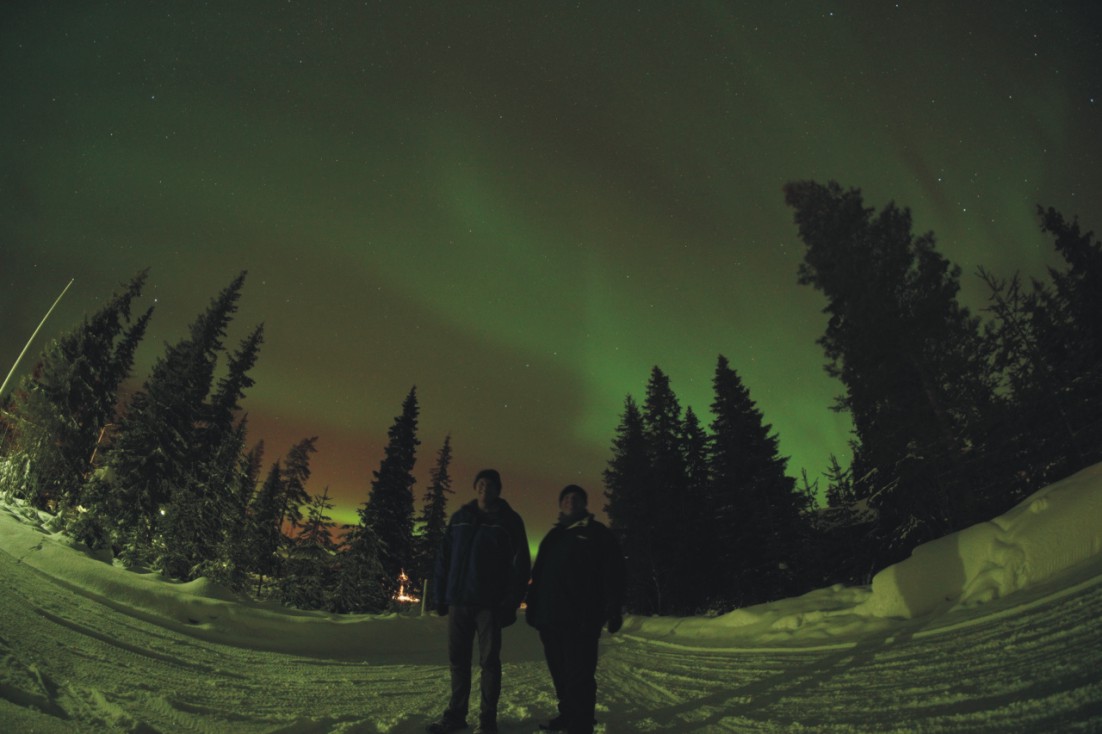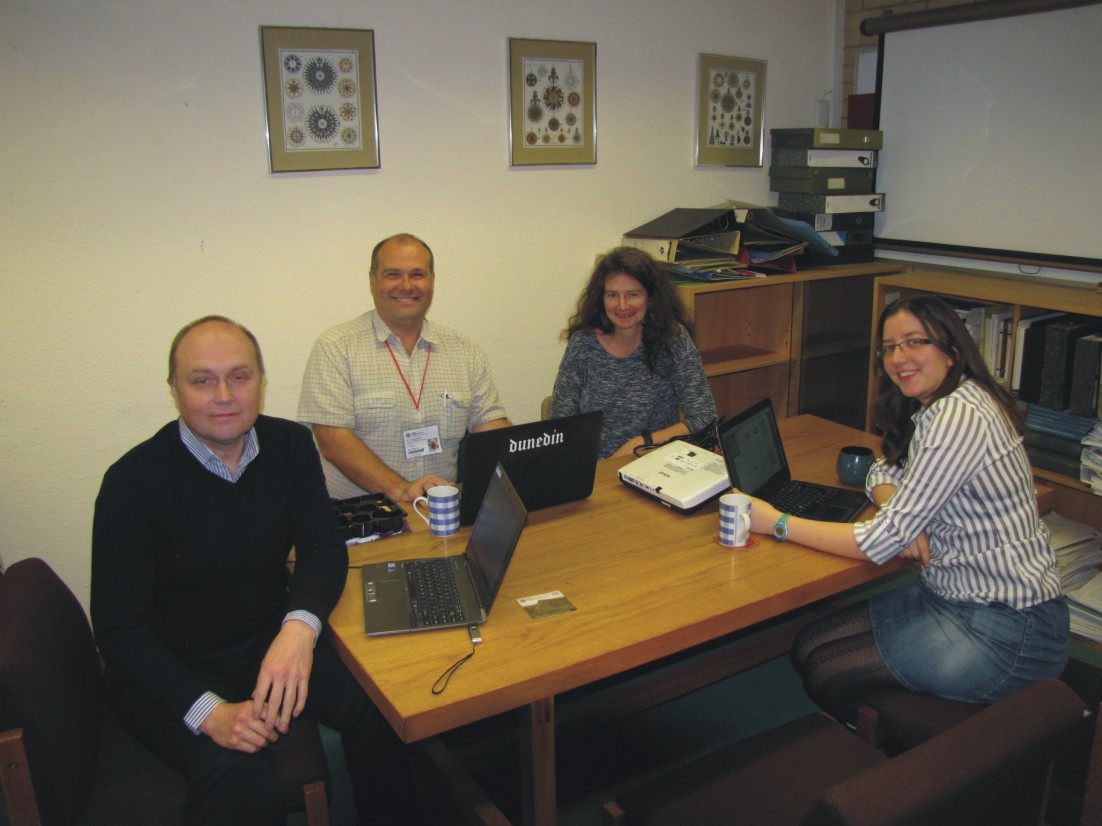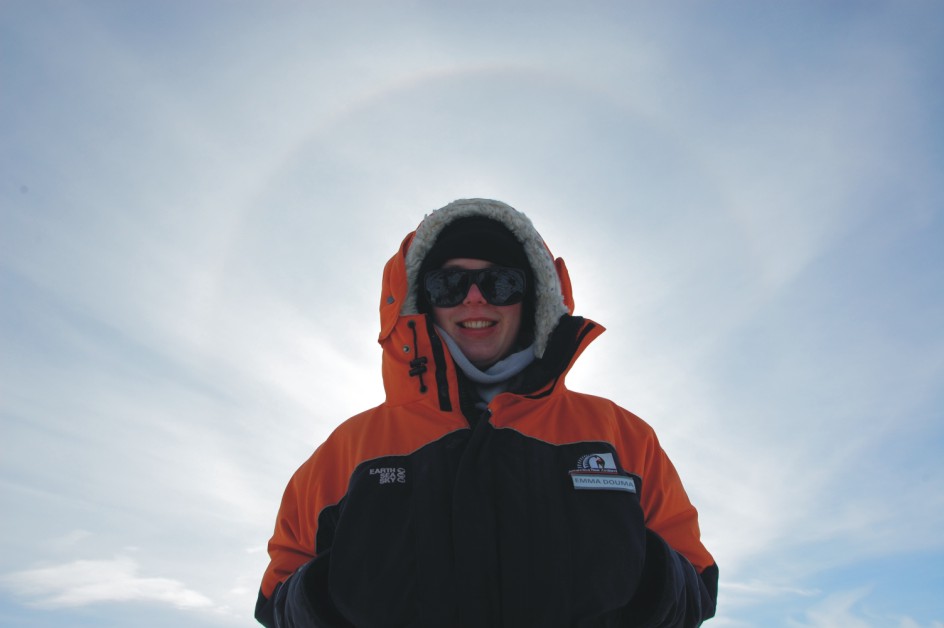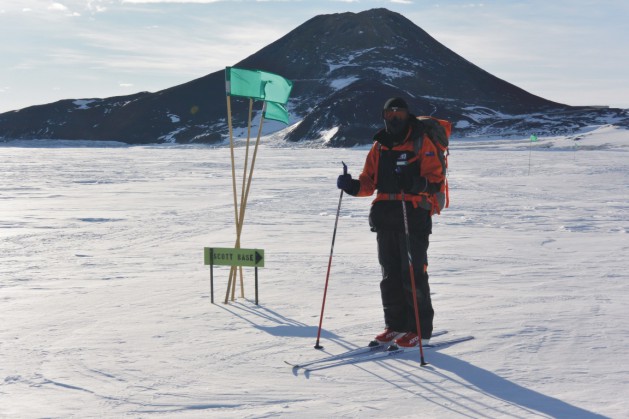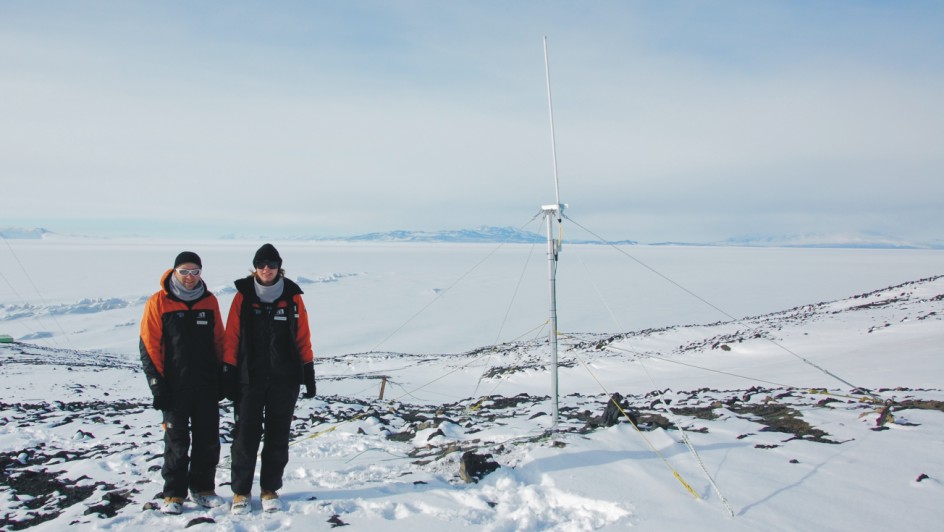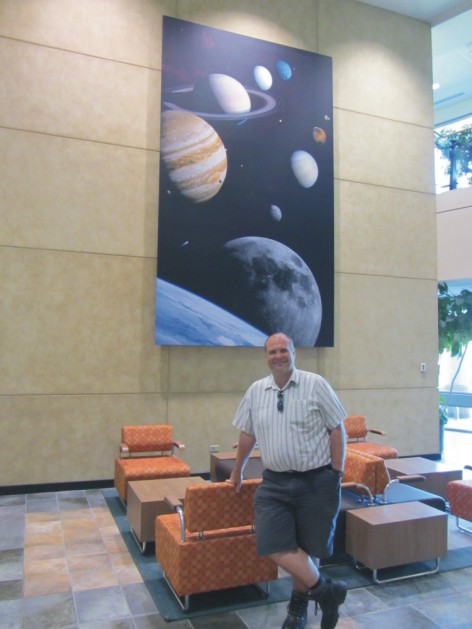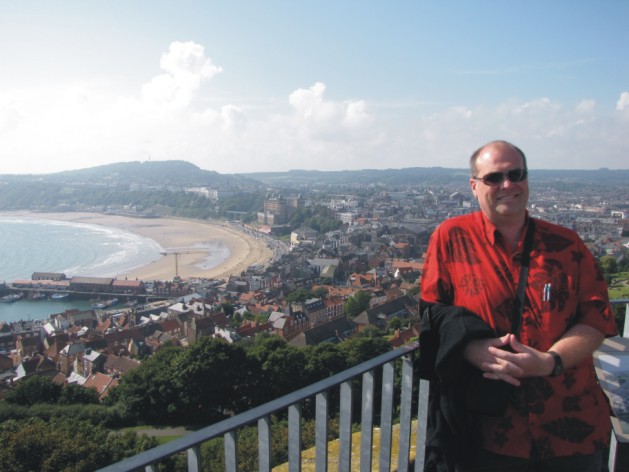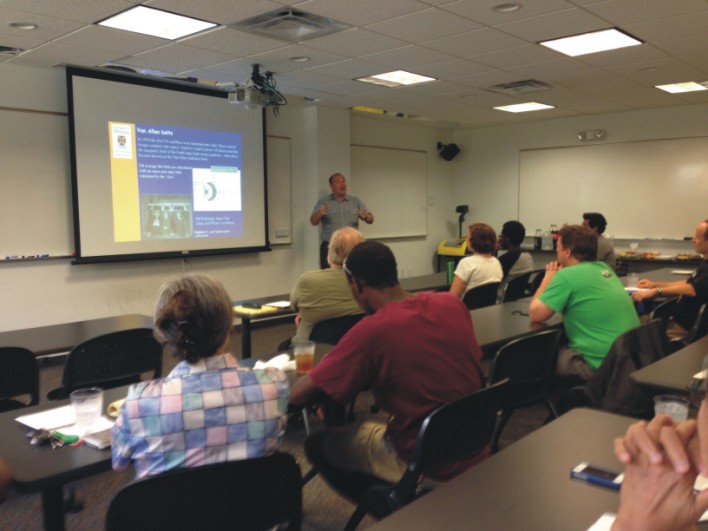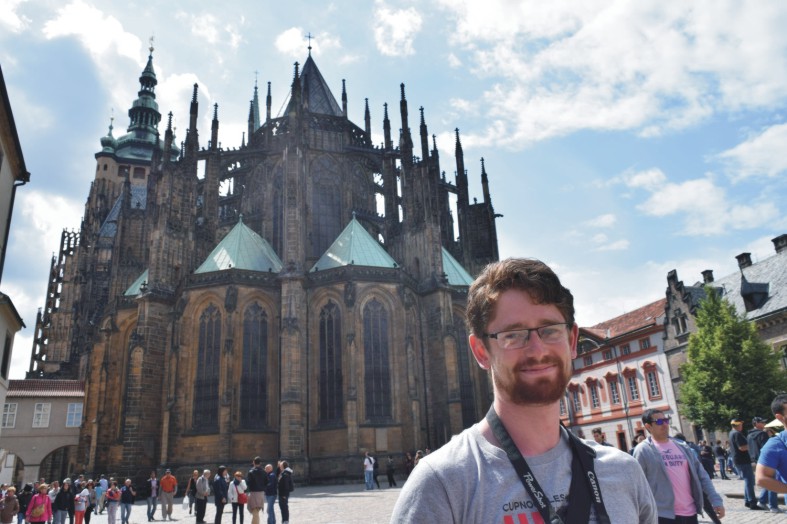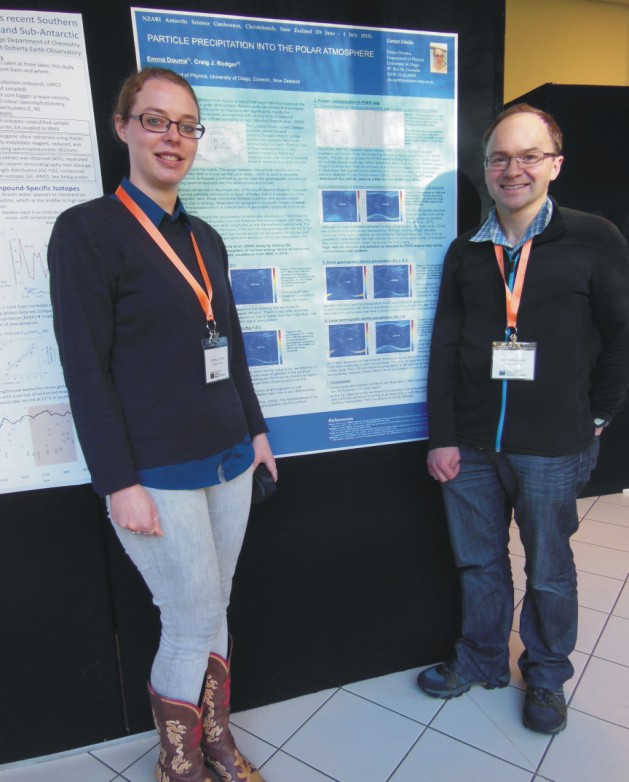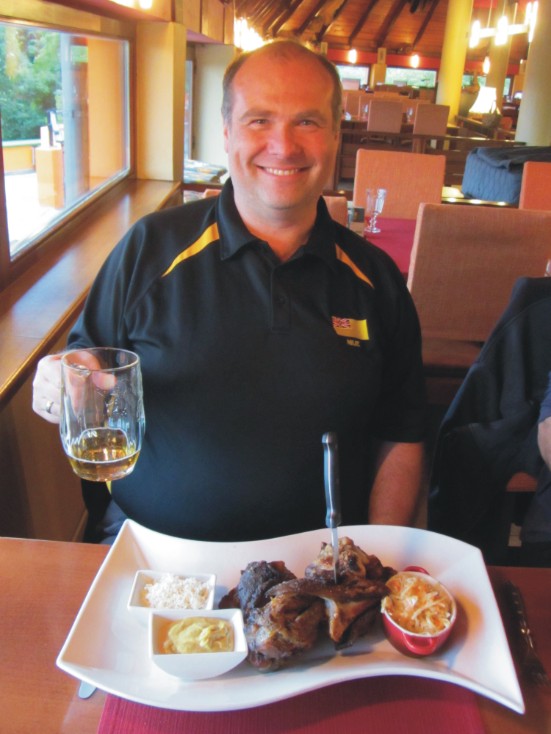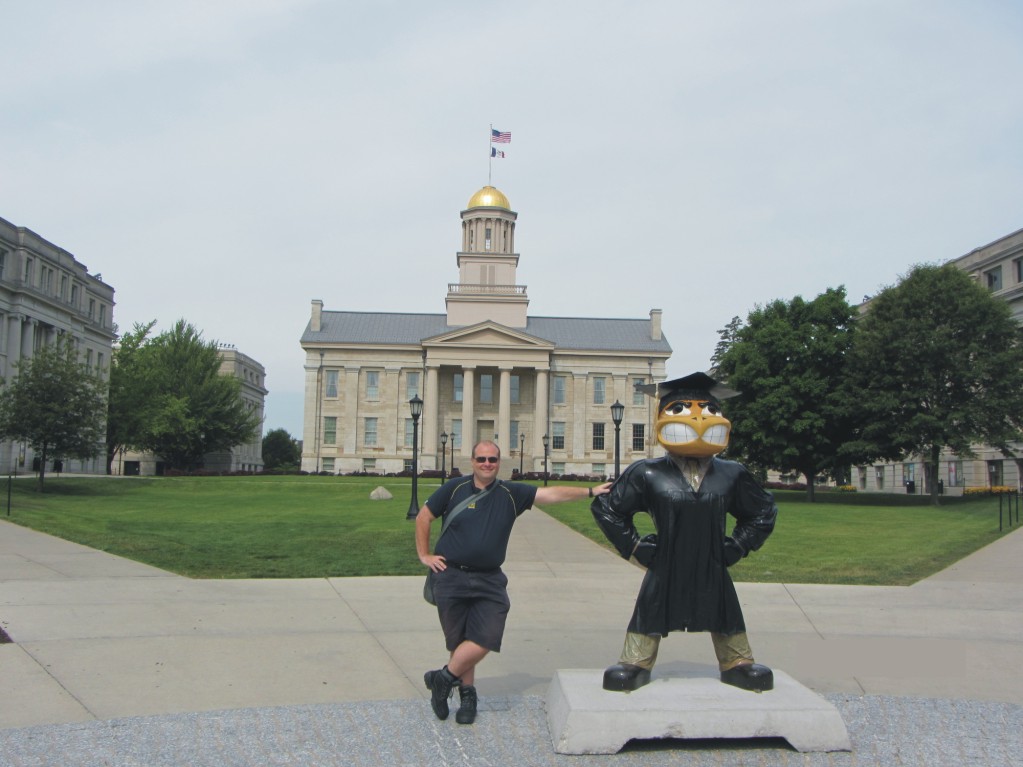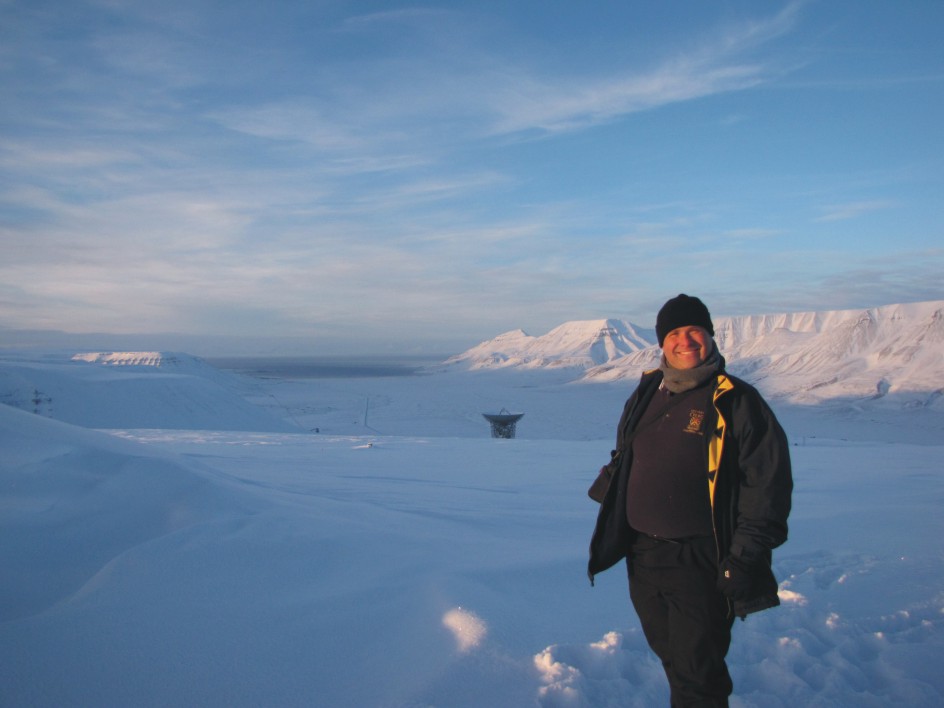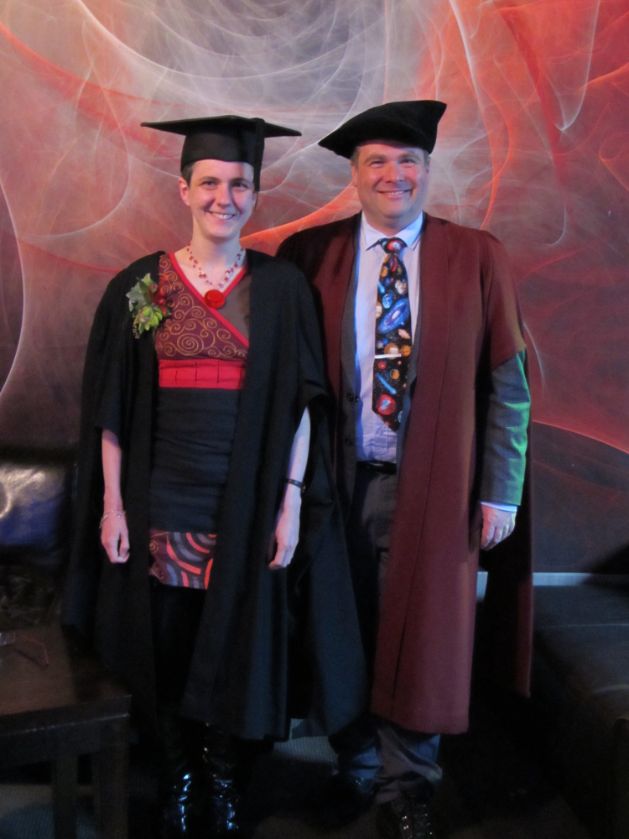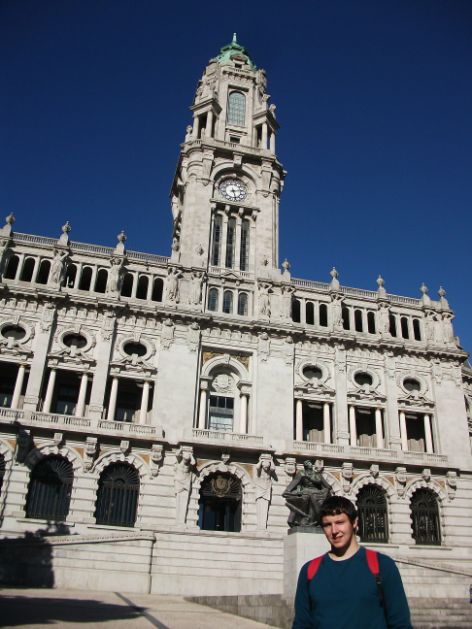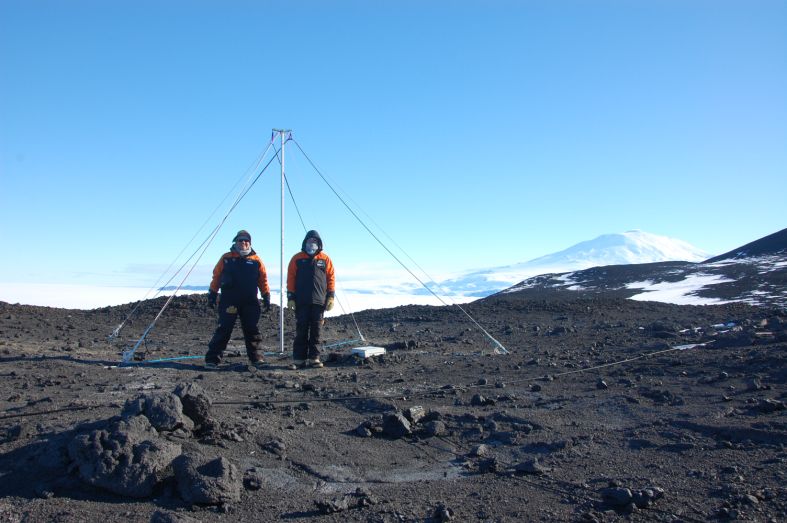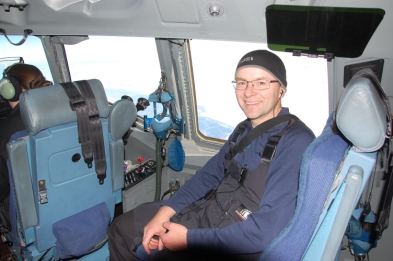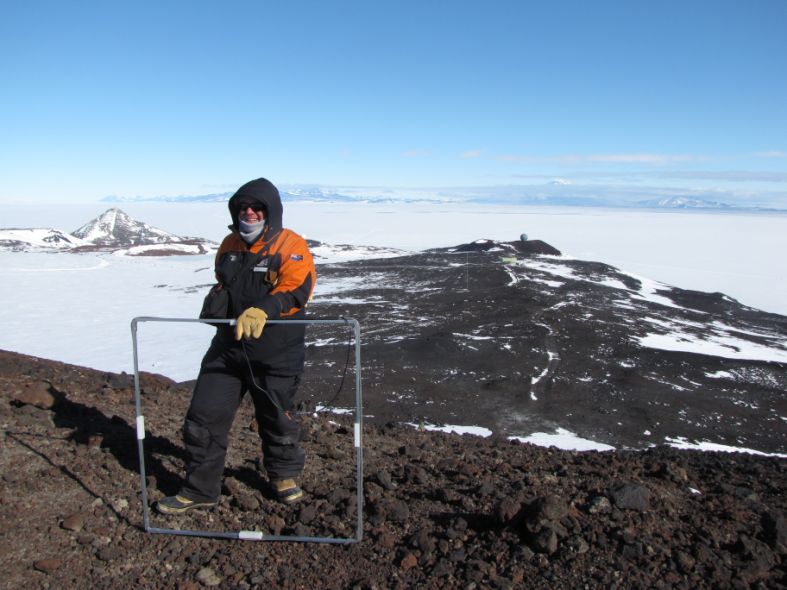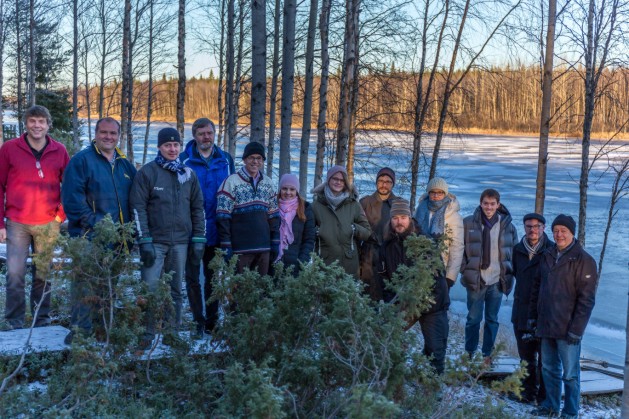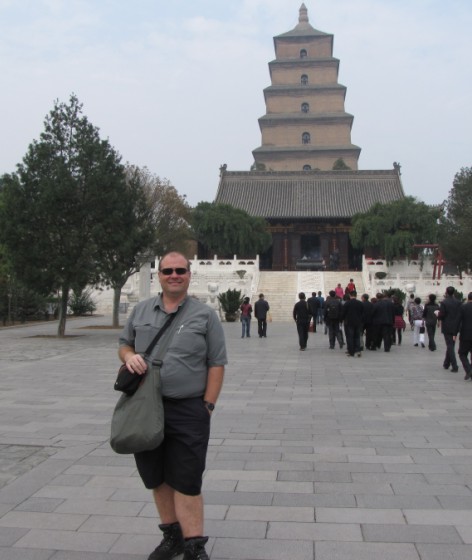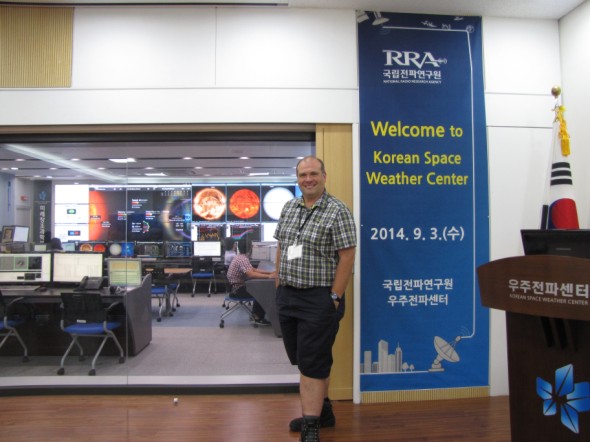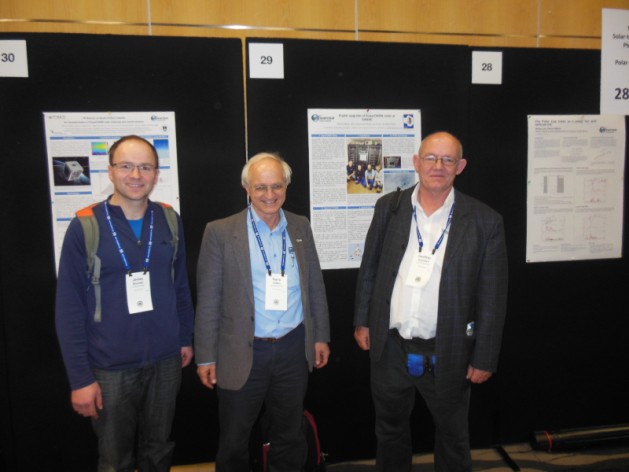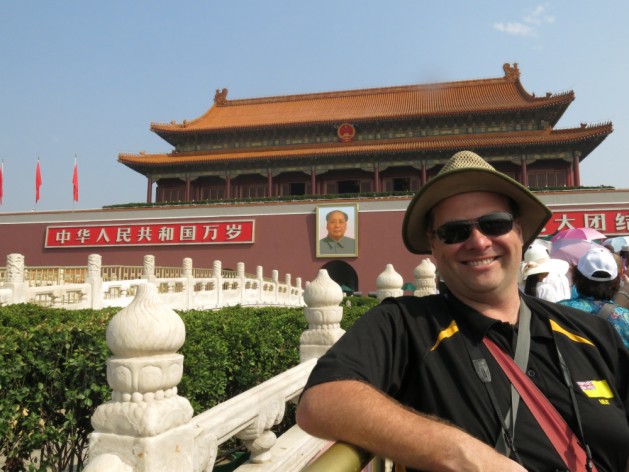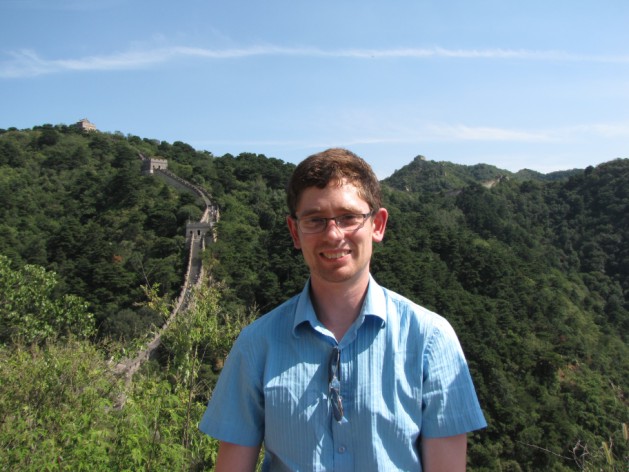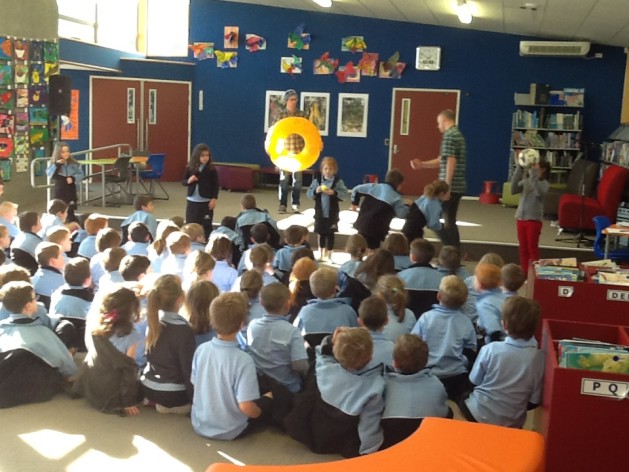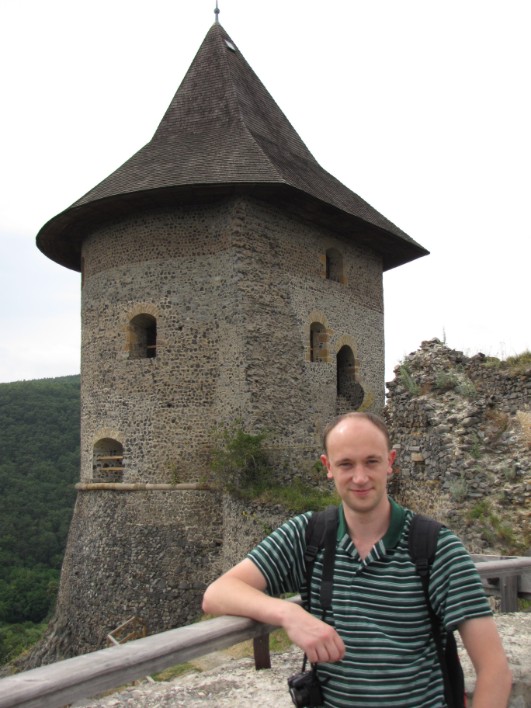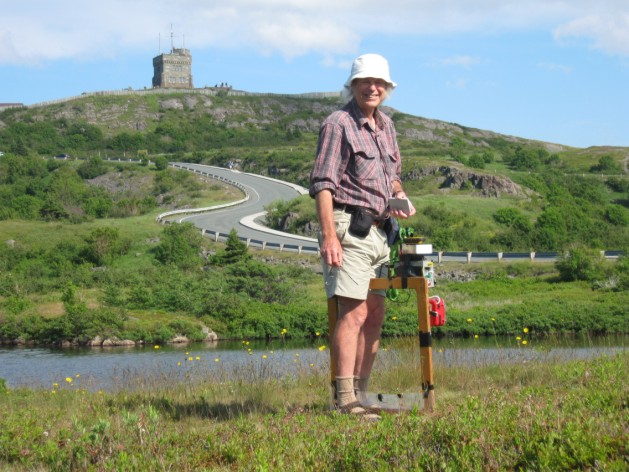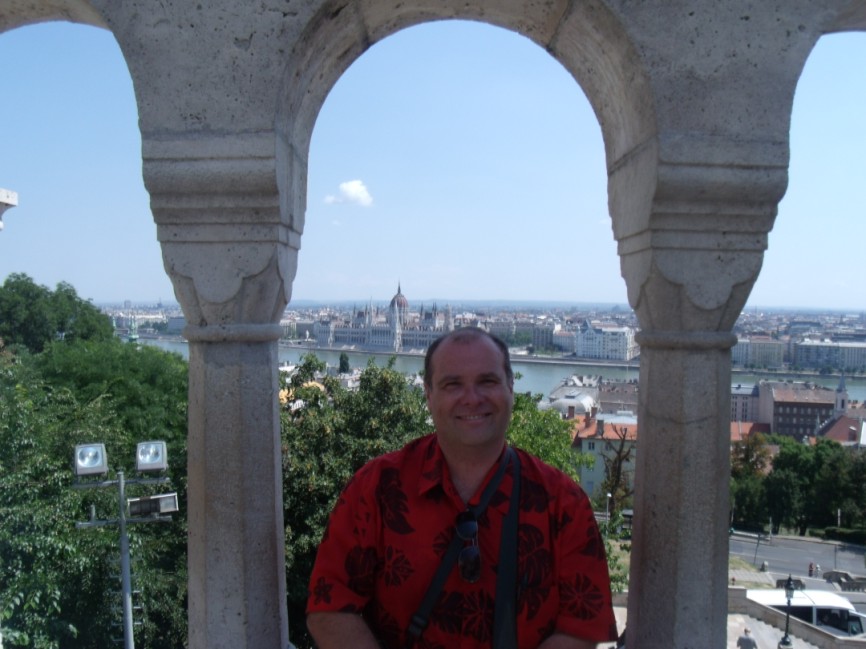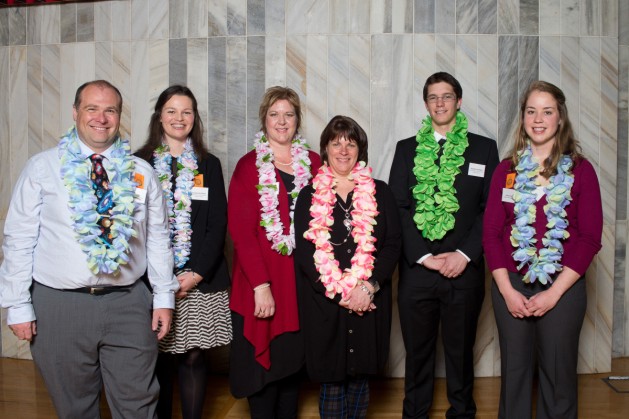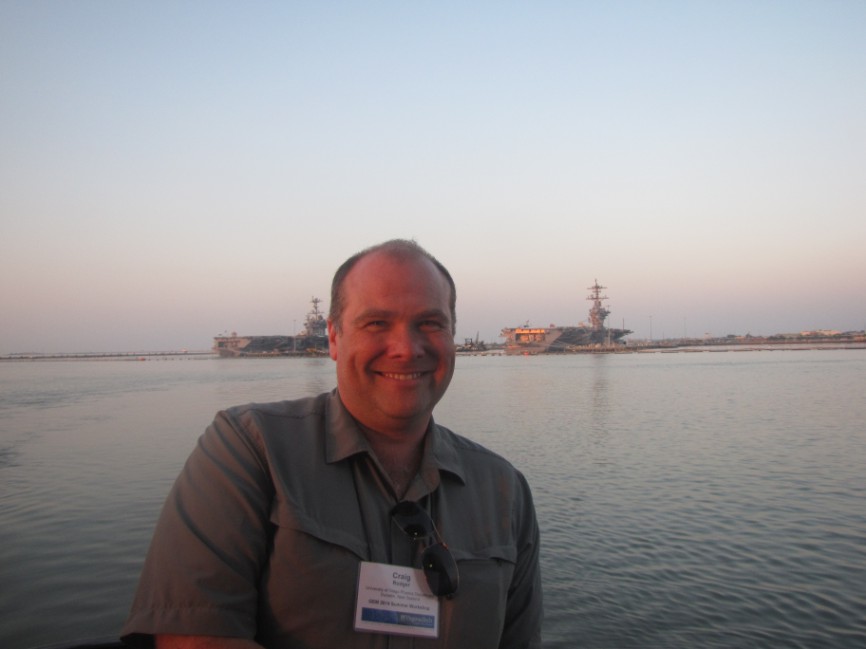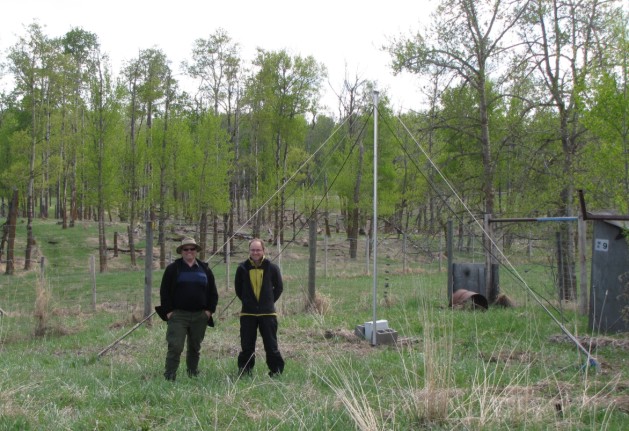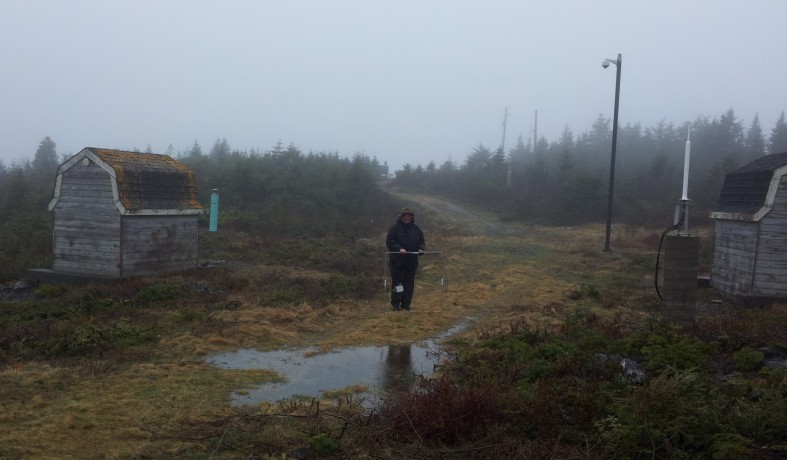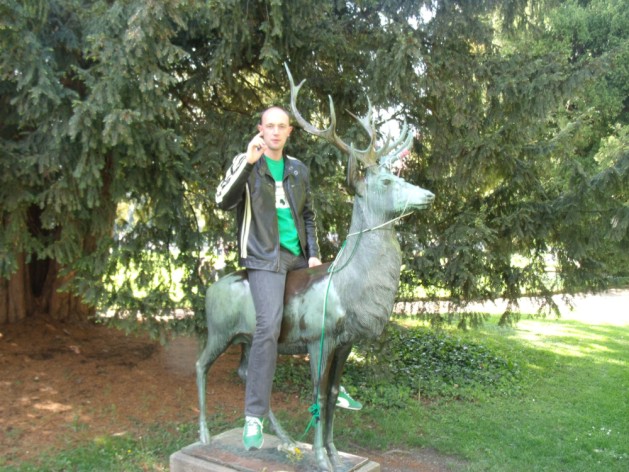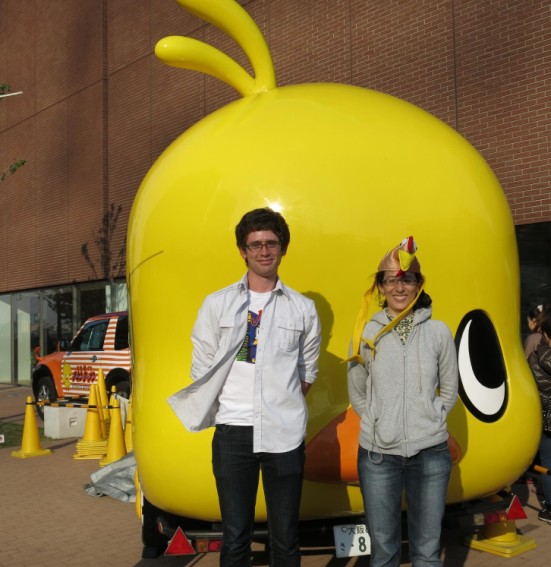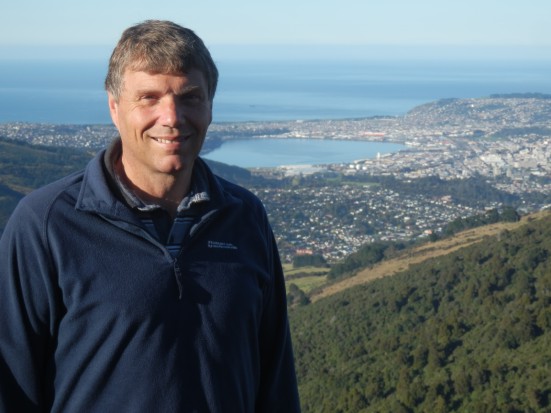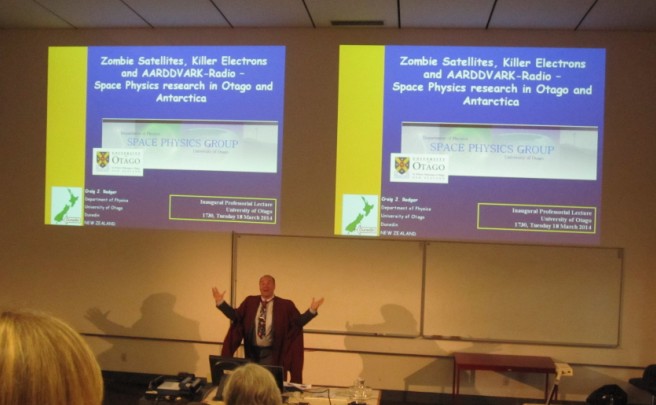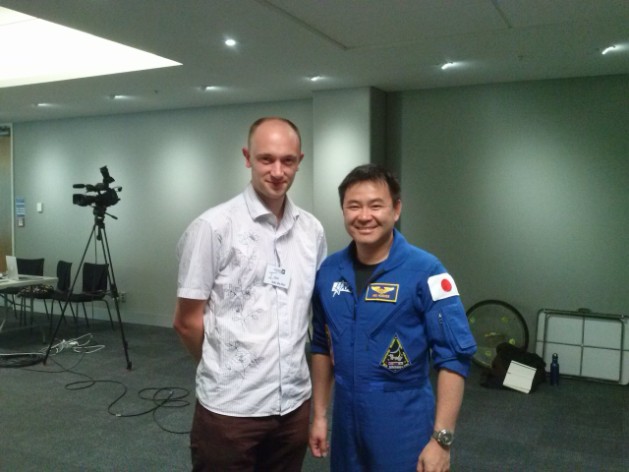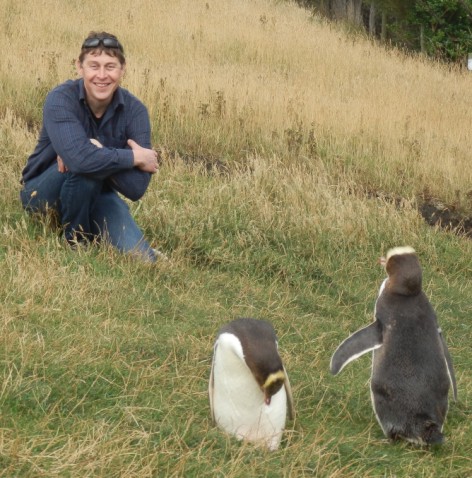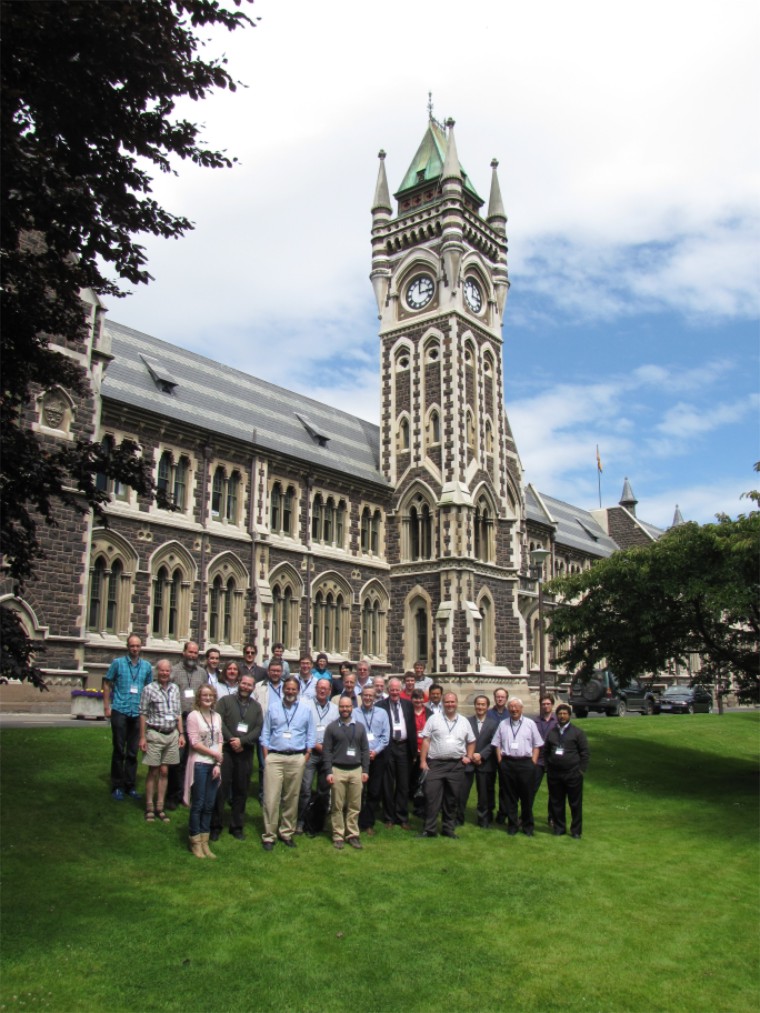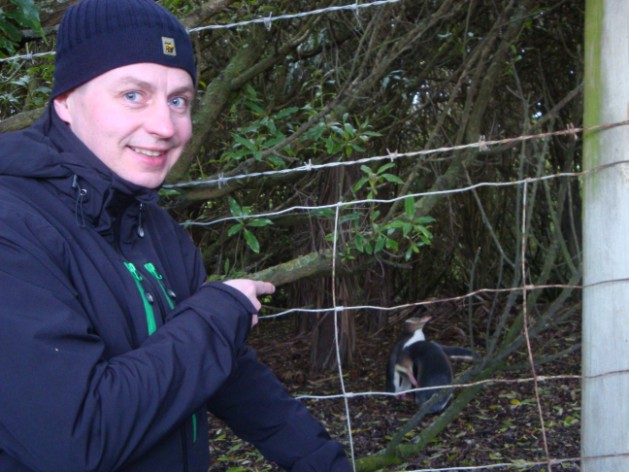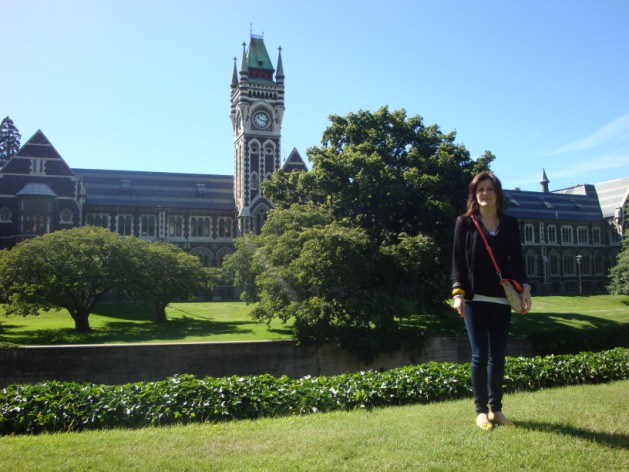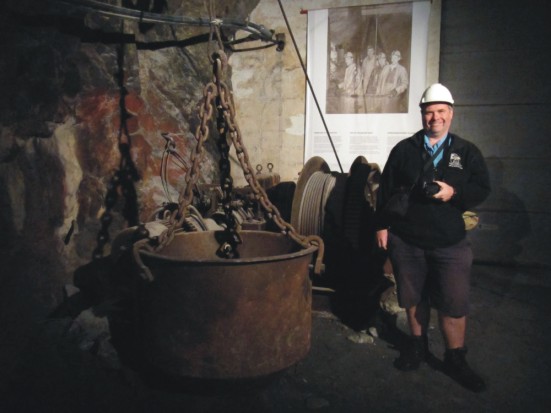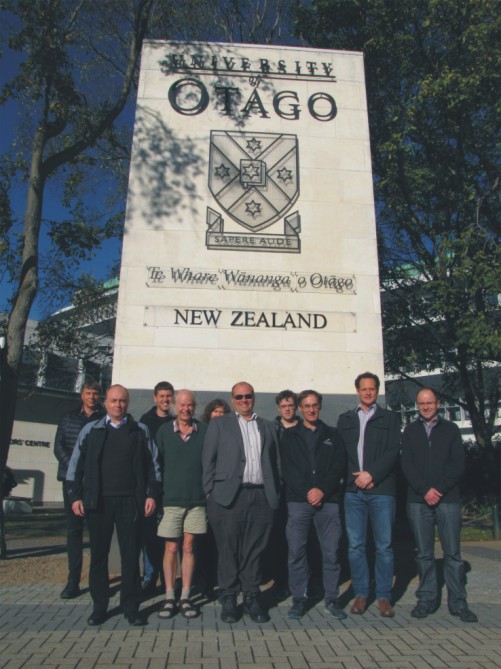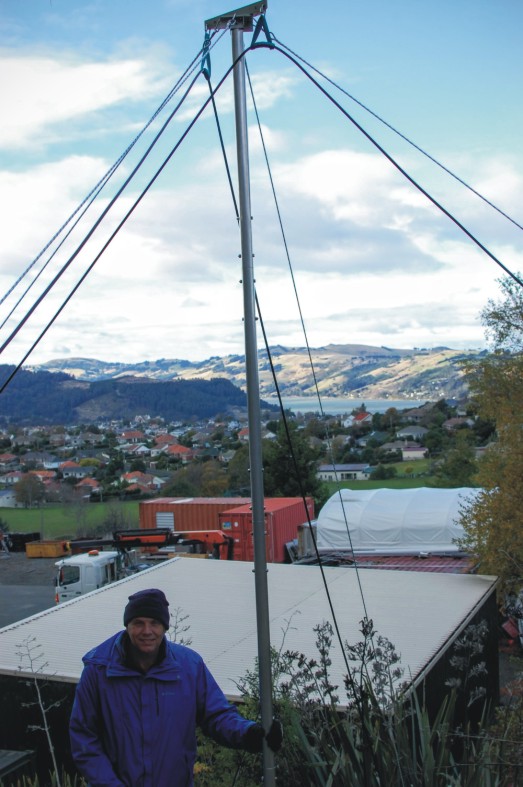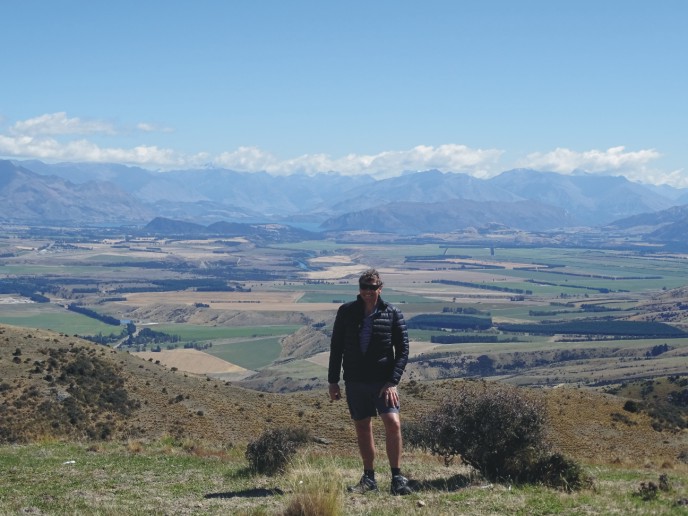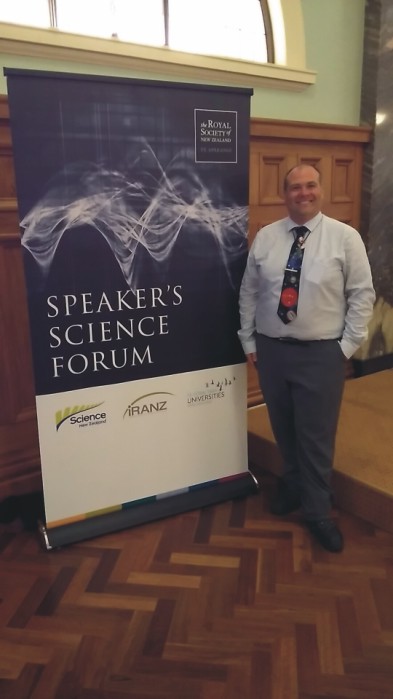Space Side Links
Quick Search
Space Physics Images 2014-2015
Images from the Otago Space Physics Group, at Home and Overseas (2014-2015)
Current images are also available
| Craig Rodger and Assoc. Prof. Sushil Kumar at the American Geophysical Union Fall Meeting in San Francisco . Dr Kumar visited the Otago Space Physics group in 2011 as the 2011 Ratu Sir Kamisese Mara Fellow. Some of the knowledge he gained during that visit is presented in this scientific poster - which Sushil gave at world's biggest geophysics meeting [17 December 2015]! |
|
| Mark Clilverd (British Antarctic Survey) and Craig Rodger admiring the aurora in Luosto, Lapland, Finland. This auroral display occurred at the start of the 2015 CHAMOS workshop hosted by the Sodankylä Geophysical Observatory [6 December 2015]. |
|
| Kick off meeting of the New Zealand-United Kingdom Geomagnetically Induced Current (GIC) research project. The New Zealand side of this new collaboration has been funded by MBIE through a recently funded Space Physics group project. The kick-off meeting was hosted by the Geomagnetism Team of the British Geological Survey (BGS), Edinburgh, Scotland. In image (left to right) Alan Thomson (BGS), Craig Rodger (Otago), Ellen Clarke (BGS), Gemma Kelly (BGS). The picture was taken by Mark Clilverd (British Antarctic Survey) on 4 December 2015. |
|
| Space Physics PhD student Emma Douma during her time working at Scott Base, Antarctica. Emma travelled south as party of Otago Space Physics Antarctic Expedition 8. In this image she is framed by a 22° ice halo, caused by ice crystals in the air scattering sunlight [23 Nov 2015]. |
|
|
James Brundell cross country skiing on the sea ice near Scot Base, Ross Island, Antarctica. He travelled on the Cape Armitage Loop, which takes one from Scott Base to McMurdo Station, across the sea ice. Cape Armitage is named after Lt. Albert B. Armitage, second in command and navigator of Robert F. Scott’s ship Discovery [21 Nov 2015]. |
|
| James Brundell and Emma Douma by the newly installed WWLLN antenna at Scot Base, Antarctica. This antenna was installed due to the growing noise problems in the Arrival Heights Antarctic Specially Protected Area, which is a radio "quiet zone" near McMurdo Station and Scott Base. Emma and James were in Antarctica for Otago Space Physics Antarctic Expedition 8 [23 Nov 2015]. |
|
| Craig in the foyer of the Space Sciences Building, Laboratory for Atmospheric and Space Physics (LASP), University of Colorado at Boulder. Craig was in Boulder for a ~3 month sabbatical supported by the Fulbright Foundation. During this time he gave a seminar and a public talk for LASP, travelled to Rice University (Houston) for a seminar, and gave another seminar in Boulder to NOAA's Space Weather Prediction Center [October 2015]. | |
| Craig Rodger stands at the end of a viewing point on the northern edge of Scarborough Castle, overlooking the town of Scarborough, Yorkshire, England. Craig was visiting to attend the Unsolved Problems in Magnetospheric Physics Workshop [11 September 2015]. |
|
| Craig Rodger giving a colloquium at Augsburg College in Minneapolis in the US state of Minnesota. Craig was invited to Augsburg to work with the Space Physics researchers there, and to give a Departmental Colloquium to Augsburg staff and students. Some attendees came across the river from the University of Minnesota [7 August 2015]. |
|
| Space Physics PhD student Kathy Cresswell-Moorcock sitting in the cockpit of a C130 Hercules aircraft. This is an operational NSF/NCAR Hercules C130 Aircraft used by the NCAR Research Aviation Facility (RAF) to undertake airborne geophysical research. Kathy was visiting the NCAR RAF during the NCAR Summer Advanced Study Programme entitled Climate, space climate, and couplings between. She was one of 23 students to take part in this years programme, which was held in Boulder, USA [8 July 2015]. | |
| Space Physics PhD student Aaron Hendry outside St. Vitus Cathedral, Prague, Czech Republic. Aaron was visiting Prague to attend the 26th IUGG General Assembly, supported by a Claude McCarthy Fellowship. [21 June 2015]. | |
| Earlier this week Space Physics group member Dr. James Brundell and PhD student Emma Douma headed to the 2015 Antarctic Science conference run by the New Zealand Antarctic Research Institute. The conference was held at Cantebury University in Christchurch, NZ [30 June 2015]. |
|
|
Craig Rodger enjoying a meal at the Restaurant Koliba Praha. Craig was in Prague to attend the 26th General Assembly of the International Union of Geodesy and Geophysics (IUGG) in the Czech Republic, from the 22 June- 2 July 2015 [22 June 2015]. |
|
| Craig Rodger at the University of Iowa in front of the Old Capitol Building. This area is called "Pentacrest" due to the 4 University buildings which surround the Old Capitol. He is leaning on a statue of Herky the Hawk, the Iowa University mascot, seen here in graduation regalia. There are a large variety of Herky statues around the state. Craig was in Iowa for a 3month sabbatical supported by the Fulbright Foundation [May 2015]. | |
| Space Physics PhD student Aaron Hendry outside Kings College, Cambridge. Aaron was visiting Cambridge to undertake a research collaboration with the British Antarctic Survey, supported by a Claude McCarthy Fellowship. While in Europe Aarion will also attend the 26th IUGG General Assembly in Prague, and have a holiday [23 May 2015]. |
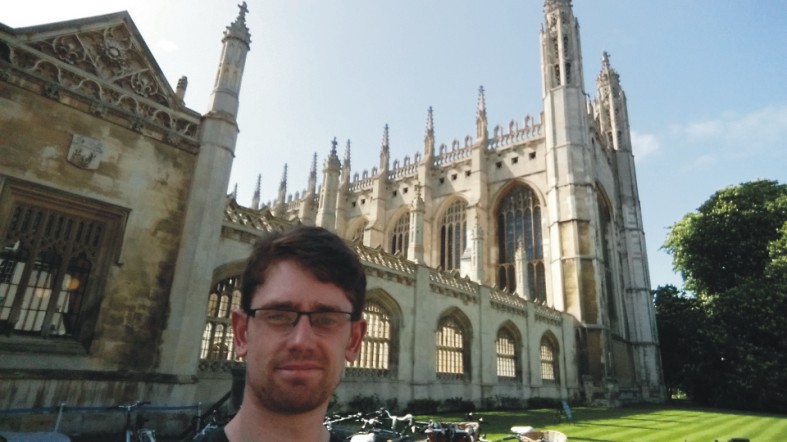 |
|
Craig Rodger at the Kjell Henriksen Observatory (KHO) in Svalbard, 15km from the town of Longyearbyen. The large radar dish in the middle of the image is the taller of the two dishes which make up the EISCAT Svalbard Radar facility. Craig was visiting Longyearbyen as an invited plenary speaker at the 5th Birkeland Centre for Space Science meeting [4 March 2015]. |
|
| Mark Clilverd (British Antarctic Survey) standing beside the memorial to Antarctic explorer Admiral Byrd. Rear Admiral Richard E. Byrd sailed from Dunedin in 1928 in his first Antarctic expedition. There is a similar memorial at McMurdo in Antarctica. Mark was in Dunedin to work with us during his annual visit [24 January 2015]. |
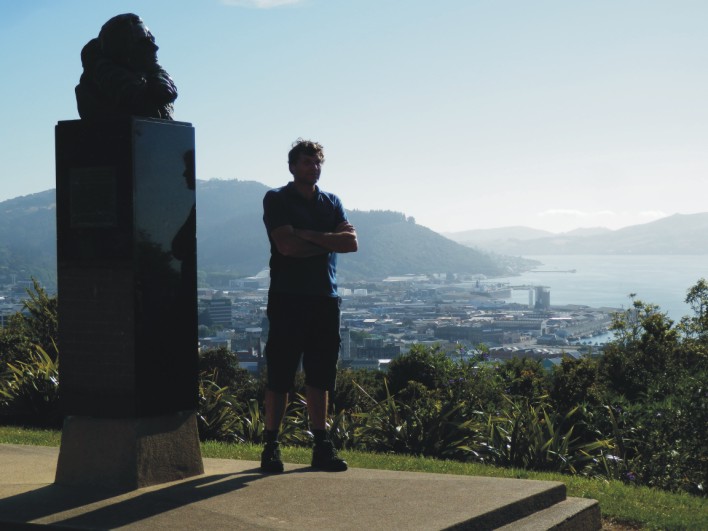 |
| Space Physics MSc research student Kathy Cresswell-Moorcock shortly after graduating at the University of Otago ceremony on Saturday 13 May. Kathy passed across to the stage to have her Master of Science with Distinction conferred. Kathy has chosen to stay with the Space Physics group, and was recently awarded a University of Otago PhD Scholarship. She will continue to work with Craig Rodger [15 December 2014]. | |
| Former Space Physics MSc student Jason Neal. Jason left the group in August this year, and is now settled in Porto, Portugal, where he is undertaking a PhD in Astronomy. Jason is standing in front of the Town Hall of Porto, which is part of the Avenida dos Aliado [30 November 2014]. |
|
| Craig Rodger and James Brundell standing by the newly repaired AARDDVARK antenna at Arrival Heights, Ross Island, Antarctica.This is located in the Arrival Heights Antarctic Specially Protected Area, which is a "quiet zone" near McMurdo Station and Scott Base. Craig and James were in Antarctica for Otago Space Physics Antarctic Expedition 7 [15 Nov 2014]. |
|
| Dr. James Brundell in one of the seats in the cockpit of a USAF C-17 Globemaster II. James was flying from Christchrch to Pegasus Field, a blue ice runway serving Ross Island. This was the start of our seventh Antarctic expedition from the Otago Space Physics group [12 Nov 2014]. |
|
| Craig Rodger on the rim of Second Crater, Ross Island, Antarctica. This is located inside the Arrival Heights Antarctic Specially Protected Area, with most of the rest of the ASPA visible in the background. Craig was undertaking magnetic field noise measurements in the VLF range, using the loop antenna he is holding. Craig was in Antarctica for Otago Space Physics Antarctic Expedition 7 [14 Nov 2014]. |
|
| Team shot during a CHAMOS group planning workshop in the village of Luosto in Lappish Finland. The image includes Craig Rodger from Otago, along with researchers from the Finnish Meteorological Institute, Sodankylä Geophysical Observatory and British Antarctic Survey. CHAMOS stands for "Chemical Aeronomy in the Mesosphere and Ozone in the Stratosphere" [6 November 2014]. | |
| Craig Rodger in front of the Big Wild Goose Pagoda in the city of Xi'an, China. Craig was visiting Xian to attend SCOSTEP's 13th Quadrennial Solar Terrestrial Symposum (18 October 2014). |
|
| Prof. Craig Rodger visiting the forecasting room of the Korean Space Weather Center on Jeju Island, Republic of Korea. Craig was in Jeju for the AGU Chapman Conferenence on Low-Frequency Waves in Space Plasmas [3 September 2014]. | |
| Dr James Brundell during the Solar Terrestrial Physics in the Polar Regions poster session at the XXXIII Scientific Committee for Antarctic Research (SCAR) Open Science Conference. James is standing next to Pierre Cilliers (SANSA Space Science) and Geoff Grantham (South African Council of Geosciences), in front of a poster being presented by Pierre. The SCAR conference was held in Auckland, New Zealand, and both James and Craig Rodger attended from the Otago Space Physics Group [26 August 2014]. | |
| Ian Whittaker and Alex Schwertheim performing Space Physics outreach at Waihola District School. The students at this rural school were participants in demonstrations on how big and cold our solar system is and asked many questions afterwards. This visit has appeared on the Blog page for Waihola School Room 2, including the students impressions of the activities. [22 August 2014]. | |
| Craig Rodger in front of Tiananmen Gate, the northern entrance to the Forbidden City in Beijing. Craig was visiting China to attend the 31st International Union of Radio Science General Assembly and Scientific Symposium at the Beijing Conference Centre. This picture was taken on a tour he had with Aaron Hendry during a day off [16 Aug 14]. | |
| Space Physics PhD student Aaron Hendry stands with the Great Wall of China in the background. Aaron and Craig were visiting the Mutianyu section of the Great Wall which is ~80km north of Beijing. We were in Beijing to attend the 31st General Assembly and Scientific Symposium of the International Union of Radio Science (URSI) [16 August 2014] |
|
| Ian Whittaker and Aaron Hendry visiting Anderson's Bay School for an afternoon of outreach to coincide with the start of the year 2/3 space teaching topic. The afternoon began with showing the scale size of the Earth and other planets to the Sun, this then extended to a distance scale where each student was assigned a planet or a number of moons and formed a human solar system including orbital motion! The afternoon continued with liquid nitrogen experiments to show the effects of how cold space is, flash freezing fruit and exploding bottles. Questions from the students were then fielded including "Are we aliens?" and "Why is space black?" [7 August 2014] |
|
| The Space Physics group had an annual team photo taken on 25 July 2014. Again we went beside "the monolith" which welcomes visitors to the University (and is beside the Physics Department building). In the photo from right to left: Alexander Schwertheim, Emma Douma, Neil Thomson, Craig Rodger, Jason Neal, Kathy Cresswell-Moorcock, James Brundell, Ian Whittaker, and Aaron Hendry. | |
| Dr. Ian Whittaker at Castle Somoska in Slovakia, just over the Hungarian boarder. The castle is associated with Šomoška village which is part of Hungary, but the end of WW2 left the village in Hungary and the castle across the boarder. Ian was visiting Hungary for the EU FP7 PLASMON project close-down meeting which took place in Budapest and Somoskőújfalu (whcih is located just south of the Slovakian boarder) [11 July 2014]. | |
| Associate Professor Neil R. Thomson making VLF measurements at St John's, Newfoundland, Canada. In the background Cabot Tower is visible situated on Signal Hill. Construction of the tower begun in 1898 to commemorate the 400th anniversary of John Cabot's discovery of Newfoundland, and Queen Victoria's Diamond Jubilee. The site where Neil is standing is very close to the point where Marconi first received radio transmissions which had been broadcast across the North Atlantic from Cornwall [13 July 2014]. | |
| Craig Rodger sitting in an arch which is part of Fisherman's Bastion on Castle Hill in Budapest. The Danube River and Hungarian Parliament can be seen in the background. Craig was visiting Hungary for the EU FP7 PLASMON project close-down meeting [6 July 2014]. | |
| Fulbright graduate and scholar award recipients Craig Rodger, Georgie Archibald, Sarah Young, Braeden Donaldson and Lorelei Curtin (all students, graduates or staff of the University of Otago) with Fulbright New Zealand Board member and University of Otago Vice-Chancellor Harlene Hayne. This image was taken at the New Zealand Parliament during the Fulbright awards ceremony on 24 July 2014. |
|
| Craig onboard the Spirit of Norfolk cruise, which hosted the conference dinner of the 2014 GEM Summer workshop (Portsmouth, Virginia, USA). The cruise went by the US Navy yards in Norfolk. The aircraft carriers USS Theodore Roosevelt (CVN 71) and USS Harry S. Truman (CVN 75) can be seen in then background [18 June 2014]. | |
| Dr James Brundell and Prof. Craig J. Rodger standing in front of the newly repaired AARDDVARK antenna installed at Ministik Lake, Alberta, Canada. The antenna is located at a field site of the Space Physics Group from the University of Alberta, who are based in Edmonton. This instrument has given us a hard time, and when we arrived we found that the track was blocked by fallen trees, the UPS was broken, the satellite modem was unreliable, one of the guy ropes had snapped, and one of the AARDDVARK cables had been biten through by a moose! [27 May 2014]. | |
| Prof. Craig J. Rodger undertaking a wideband VLF noise measurement close to the AARDDVARK receiver which is on the site of the St. John's Magnetic Observatory. This is a Natural Resources Canada Space Weather Forecast Centre site, in St. John's, Newfoundland, Canada. Craig and James visited St. Johns to upgrade this AARDDVARK receiver to join the WWLLN network [21 May2014]. | |
| Dr. Ian Whittaker in Zürich, Switzerland following the European Geosciences Union general assembly 2014 in Vienna, where he presented a talk and three posters. The visit to Zurich was en-route to Aberystwyth University, UK where he gave a talk and assisted with collaborative work on Venus Express [May 2014]. |
|
| Space Physics PhD student Aaron Hendry with Claudia Martinez, a PhD student at the Solar-Terrestrial Environment Laboratory of Nagoya University, in front of the Cup Noodle Musem in Yokohama, Japan. The giant yellow chicken van is Hiyoko-chan, the mascot of the Nissin Chikin Ramen noodle brand. Aaron was in Japan to attend the 2014 Japan Geoscience Union Meeting in Yokohama, Japan [26 April 2014]. | |
| Mark Clilverd (British Antarctic Survey) on Mount Cargill with the city of Dunedin in the background. Mark was in Dunedin as part of a ~3 month visit to the Space Physics group during his sabbatical [March 2014]. | |
| Professor Craig Rodger at the beginning of his Inaugural Professorial Lecture on 18 March 2014. It was a full house. The lecture was videoed, and will appear on the University of Otago iTunes site soon [March 2014]. |
|
| Space Physics PostDoc Dr. Ian Whittaker with Japanese astronaut Akihiko Hoshide. Ian and Akihiko were in Auckland fro the SpaceUp New Zealand conference (15-16 February 2014). |
|
| Neil Cobbett (Research Engineer, British Antarctic Survey) viewing some locals near Dunedin. Neil was visiting the Space Physics group to work on upgraded automous VLF detector systems to be employed deep into the field in the Antarctic [January 2014] |
|
| Participants picture outside the University of Otago clocktower building during the 6th VERSIM Workshop which occurred in Dunedin and hosted by the Space Physics Research Group [20 January 2014]. | |
| Dr. Pekka Verronen (Finnish Meteorological Institute) beside two Yellow-Eyed Pengions at Kaitiki Point, near the village of Moeraki. Pekka was visiting the Otago Space Physics group for a few days before travelling to Queenstown for the SPARC 2014 General Assembly [8 January 2014]. | |
| Dr. Monika Andersson (Finnish Meteorological Institute) outside the University of Otago Clocktower building. Monika visited the Otago Space Physics group for a few days before travelling to Queenstown for the SPARC 2014 General Assembly [6 January 2014]. |
What to see more images? Look at our current images, images from 2012-2013, images from 2010-2011, images from 2008-2009, images from 2006-2007 or the images from 2004-2005 or the images from 1997-2003!
Images from the Otago Space Physics Group, at Home and Overseas
| Space Physics PhD student Emma Douma left from Dunedin airport to attend the Geospace Environment Modeling 2016 Summer Workshop in Santa Fe, New Mexico (19 - 24 June), after which she spent a week travelling around New Mexico. She gave a poster presentation at this meeting. | 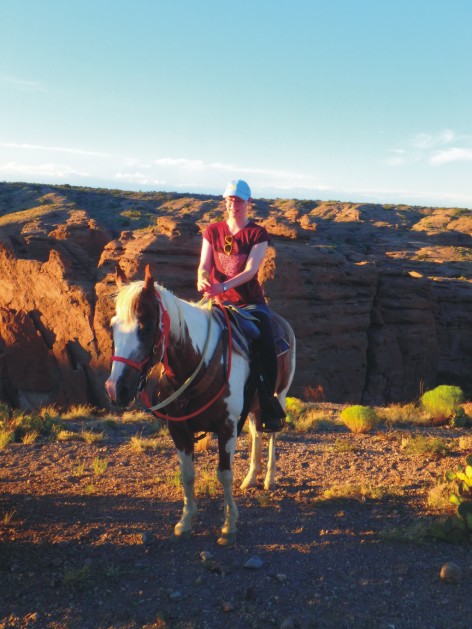 |
| Craig in the Tytyri Mine Museum, 80m below Lake Lohja. This is a major supplier of limestone in Finland, and the operational part of mine is nearly 400m underground. Craig was in Finland to take part in the 6th international HEPPA-SOLARIS workshop in Helsinki [20 June 2016]. |
|
| On 25 May 2016 we had the kick-off meeting for our MBIE-funded Geomagnetically Induced Current research project, hosted at the Otago University Physics Department. The participants were: Mark Clilverd (British Antarctic Survey), Alan Thomson (British Geological Survey), Mike Dalzell (Transpower), Neil Thomson (Otago), Ellen Clarke (British Geological Survey), Craig Rodger (Otago), Daniel Mac Manus (Otago), Malcolm Ingham (VUW), Tim Divett (Otago), James Brundell (Otago). |
|
| Alan Thomson and Ellen Carke (British Geological Survey) came to Dunedin for 2 weeks to work with us on our MBIE-funded Geomagnetically Induced Current research project. Alan and Ellen work in the BGS Geomagnetism team based in Edinburgh, Dunedin's sister city. Both are international leaders in Space Weather work, and we were thrilled to work with them on our new joint New Zealand - United Kingdom project [May 2016]. |
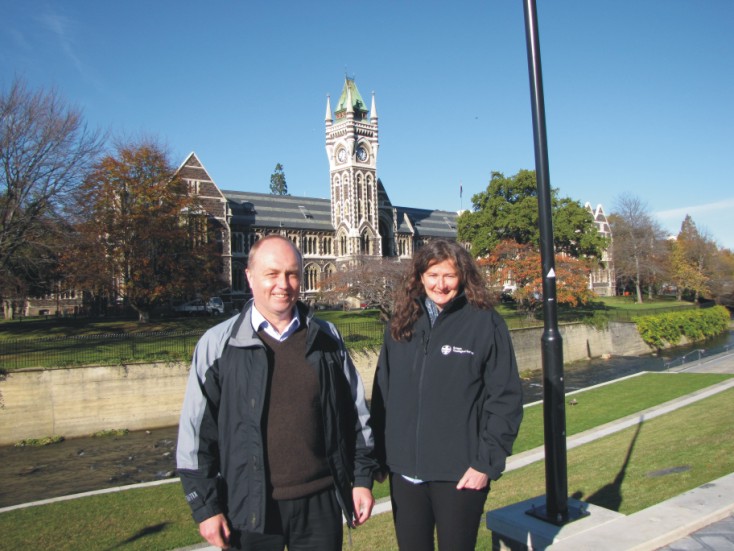 |
| In May 2016 Mark Clilverd (British Antarctic Survey) came to Dunedin to be part of our MBIE-funded Geomagnetically Induced Current research project. As part of this effort we installed a wideband VLF instrument to monitor harmonics from a major electrical substation on the edge of Dunedin city. Here Mark stands by the newly installed equipment [18 May 2016]. |
|
| Once again in 2016 Mark Clilverd (British Antarctic Survey) visited the Otago Space Physics Group. This year Mark and his wife Sal were here for about a month. Here Mark is seen during a long weeknd they took in Central Otago. The image shows Lake Wanaka and the Southern Alps in the background, taken from the skyline ridge track of the Grandview Range [March 2016]. |
|
| On 2 March 2016 Craig Rodger gave one of the two talks at the Royal Society of New Zealand 2016 Speaker’s Science Forum. Prof Rodger gave a talk entitled Space Weather: Hazards to the Electrical Network from Solar Explosions in the Grand Hall, Parliament Buildings. The Speaker’s Science Forum is an opportunity for Members of Parliament and decision makers to hear cutting edge science thinking in a non-partisan setting. This event was hosted by Dr Jian Yang (Chair of the Education and Science Committee) [2 March 2016]. | |
| Craig Rodger and Assoc. Prof. Sushil Kumar at the American Geophysical Union Fall Meeting in San Francisco . Dr Kumar visited the Otago Space Physics group in 2011 as the 2011 Ratu Sir Kamisese Mara Fellow. Some of the knowledge he gained during that visit is presented in this scientific poster - which Sushil gave at world's biggest geophysics meeting [17 December 2015]! |
|
| Mark Clilverd (British Antarctic Survey) and Craig Rodger admiring the aurora in Luosto, Lapland, Finland. This auroral display occurred at the start of the 2015 CHAMOS workshop hosted by the Sodankylä Geophysical Observatory [6 December 2015]. |
|
| Kick off meeting of the New Zealand-United Kingdom Geomagnetically Induced Current (GIC) research project. The New Zealand side of this new collaboration has been funded by MBIE through a recently funded Space Physics group project. The kick-off meeting was hosted by the Geomagnetism Team of the British Geological Survey (BGS), Edinburgh, Scotland. In image (left to right) Alan Thomson (BGS), Craig Rodger (Otago), Ellen Clarke (BGS), Gemma Kelly (BGS). The picture was taken by Mark Clilverd (British Antarctic Survey) on 4 December 2015. |
|
| Space Physics PhD student Emma Douma during her time working at Scott Base, Antarctica. Emma travelled south as party of Otago Space Physics Antarctic Expedition 8. In this image she is framed by a 22° ice halo, caused by ice crystals in the air scattering sunlight [23 Nov 2015]. |
|
|
James Brundell cross country skiing on the sea ice near Scot Base, Ross Island, Antarctica. He travelled on the Cape Armitage Loop, which takes one from Scott Base to McMurdo Station, across the sea ice. Cape Armitage is named after Lt. Albert B. Armitage, second in command and navigator of Robert F. Scott’s ship Discovery [21 Nov 2015]. |
|
| James Brundell and Emma Douma by the newly installed WWLLN antenna at Scot Base, Antarctica. This antenna was installed due to the growing noise problems in the Arrival Heights Antarctic Specially Protected Area, which is a radio "quiet zone" near McMurdo Station and Scott Base. Emma and James were in Antarctica for Otago Space Physics Antarctic Expedition 8 [23 Nov 2015]. |
|
| Craig in the foyer of the Space Sciences Building, Laboratory for Atmospheric and Space Physics (LASP), University of Colorado at Boulder. Craig was in Boulder for a ~3 month sabbatical supported by the Fulbright Foundation. During this time he gave a seminar and a public talk for LASP, travelled to Rice University (Houston) for a seminar, and gave another seminar in Boulder to NOAA's Space Weather Prediction Center [October 2015]. | |
| Craig Rodger stands at the end of a viewing point on the northern edge of Scarborough Castle, overlooking the town of Scarborough, Yorkshire, England. Craig was visiting to attend the Unsolved Problems in Magnetospheric Physics Workshop [11 September 2015]. |
|
| Craig Rodger giving a colloquium at Augsburg College in Minneapolis in the US state of Minnesota. Craig was invited to Augsburg to work with the Space Physics researchers there, and to give a Departmental Colloquium to Augsburg staff and students. Some attendees came across the river from the University of Minnesota [7 August 2015]. |
|
| Space Physics PhD student Kathy Cresswell-Moorcock sitting in the cockpit of a C130 Hercules aircraft. This is an operational NSF/NCAR Hercules C130 Aircraft used by the NCAR Research Aviation Facility (RAF) to undertake airborne geophysical research. Kathy was visiting the NCAR RAF during the NCAR Summer Advanced Study Programme entitled Climate, space climate, and couplings between. She was one of 23 students to take part in this years programme, which was held in Boulder, USA [8 July 2015]. | |
| Space Physics PhD student Aaron Hendry outside St. Vitus Cathedral, Prague, Czech Republic. Aaron was visiting Prague to attend the 26th IUGG General Assembly, supported by a Claude McCarthy Fellowship. [21 June 2015]. | |
| Earlier this week Space Physics group member Dr. James Brundell and PhD student Emma Douma headed to the 2015 Antarctic Science conference run by the New Zealand Antarctic Research Institute. The conference was held at Cantebury University in Christchurch, NZ [30 June 2015]. |
|
|
Craig Rodger enjoying a meal at the Restaurant Koliba Praha. Craig was in Prague to attend the 26th General Assembly of the International Union of Geodesy and Geophysics (IUGG) in the Czech Republic, from the 22 June- 2 July 2015 [22 June 2015]. |
|
| Craig Rodger at the University of Iowa in front of the Old Capitol Building. This area is called "Pentacrest" due to the 4 University buildings which surround the Old Capitol. He is leaning on a statue of Herky the Hawk, the Iowa University mascot, seen here in graduation regalia. There are a large variety of Herky statues around the state. Craig was in Iowa for a 3month sabbatical supported by the Fulbright Foundation [May 2015]. | |
| Space Physics PhD student Aaron Hendry outside Kings College, Cambridge. Aaron was visiting Cambridge to undertake a research collaboration with the British Antarctic Survey, supported by a Claude McCarthy Fellowship. While in Europe Aarion will also attend the 26th IUGG General Assembly in Prague, and have a holiday [23 May 2015]. |
 |
|
Craig Rodger at the Kjell Henriksen Observatory (KHO) in Svalbard, 15km from the town of Longyearbyen. The large radar dish in the middle of the image is the taller of the two dishes which make up the EISCAT Svalbard Radar facility. Craig was visiting Longyearbyen as an invited plenary speaker at the 5th Birkeland Centre for Space Science meeting [4 March 2015]. |
|
| Mark Clilverd (British Antarctic Survey) standing beside the memorial to Antarctic explorer Admiral Byrd. Rear Admiral Richard E. Byrd sailed from Dunedin in 1928 in his first Antarctic expedition. There is a similar memorial at McMurdo in Antarctica. Mark was in Dunedin to work with us during his annual visit [24 January 2015]. |
 |
| Space Physics MSc research student Kathy Cresswell-Moorcock shortly after graduating at the University of Otago ceremony on Saturday 13 May. Kathy passed across to the stage to have her Master of Science with Distinction conferred. Kathy has chosen to stay with the Space Physics group, and was recently awarded a University of Otago PhD Scholarship. She will continue to work with Craig Rodger [15 December 2014]. | |
| Former Space Physics MSc student Jason Neal. Jason left the group in August this year, and is now settled in Porto, Portugal, where he is undertaking a PhD in Astronomy. Jason is standing in front of the Town Hall of Porto, which is part of the Avenida dos Aliado [30 November 2014]. |
|
| Craig Rodger and James Brundell standing by the newly repaired AARDDVARK antenna at Arrival Heights, Ross Island, Antarctica.This is located in the Arrival Heights Antarctic Specially Protected Area, which is a "quiet zone" near McMurdo Station and Scott Base. Craig and James were in Antarctica for Otago Space Physics Antarctic Expedition 7 [15 Nov 2014]. |
|
| Dr. James Brundell in one of the seats in the cockpit of a USAF C-17 Globemaster II. James was flying from Christchrch to Pegasus Field, a blue ice runway serving Ross Island. This was the start of our seventh Antarctic expedition from the Otago Space Physics group [12 Nov 2014]. |
|
| Craig Rodger on the rim of Second Crater, Ross Island, Antarctica. This is located inside the Arrival Heights Antarctic Specially Protected Area, with most of the rest of the ASPA visible in the background. Craig was undertaking magnetic field noise measurements in the VLF range, using the loop antenna he is holding. Craig was in Antarctica for Otago Space Physics Antarctic Expedition 7 [14 Nov 2014]. |
|
| Team shot during a CHAMOS group planning workshop in the village of Luosto in Lappish Finland. The image includes Craig Rodger from Otago, along with researchers from the Finnish Meteorological Institute, Sodankylä Geophysical Observatory and British Antarctic Survey. CHAMOS stands for "Chemical Aeronomy in the Mesosphere and Ozone in the Stratosphere" [6 November 2014]. | |
| Craig Rodger in front of the Big Wild Goose Pagoda in the city of Xi'an, China. Craig was visiting Xian to attend SCOSTEP's 13th Quadrennial Solar Terrestrial Symposum (18 October 2014). |
|
| Prof. Craig Rodger visiting the forecasting room of the Korean Space Weather Center on Jeju Island, Republic of Korea. Craig was in Jeju for the AGU Chapman Conferenence on Low-Frequency Waves in Space Plasmas [3 September 2014]. | |
| Dr James Brundell during the Solar Terrestrial Physics in the Polar Regions poster session at the XXXIII Scientific Committee for Antarctic Research (SCAR) Open Science Conference. James is standing next to Pierre Cilliers (SANSA Space Science) and Geoff Grantham (South African Council of Geosciences), in front of a poster being presented by Pierre. The SCAR conference was held in Auckland, New Zealand, and both James and Craig Rodger attended from the Otago Space Physics Group [26 August 2014]. | |
| Ian Whittaker and Alex Schwertheim performing Space Physics outreach at Waihola District School. The students at this rural school were participants in demonstrations on how big and cold our solar system is and asked many questions afterwards. This visit has appeared on the Blog page for Waihola School Room 2, including the students impressions of the activities. [22 August 2014]. | |
| Craig Rodger in front of Tiananmen Gate, the northern entrance to the Forbidden City in Beijing. Craig was visiting China to attend the 31st International Union of Radio Science General Assembly and Scientific Symposium at the Beijing Conference Centre. This picture was taken on a tour he had with Aaron Hendry during a day off [16 Aug 14]. | |
| Space Physics PhD student Aaron Hendry stands with the Great Wall of China in the background. Aaron and Craig were visiting the Mutianyu section of the Great Wall which is ~80km north of Beijing. We were in Beijing to attend the 31st General Assembly and Scientific Symposium of the International Union of Radio Science (URSI) [16 August 2014] |
|
| Ian Whittaker and Aaron Hendry visiting Anderson's Bay School for an afternoon of outreach to coincide with the start of the year 2/3 space teaching topic. The afternoon began with showing the scale size of the Earth and other planets to the Sun, this then extended to a distance scale where each student was assigned a planet or a number of moons and formed a human solar system including orbital motion! The afternoon continued with liquid nitrogen experiments to show the effects of how cold space is, flash freezing fruit and exploding bottles. Questions from the students were then fielded including "Are we aliens?" and "Why is space black?" [7 August 2014] |
|
| The Space Physics group had an annual team photo taken on 25 July 2014. Again we went beside "the monolith" which welcomes visitors to the University (and is beside the Physics Department building). In the photo from right to left: Alexander Schwertheim, Emma Douma, Neil Thomson, Craig Rodger, Jason Neal, Kathy Cresswell-Moorcock, James Brundell, Ian Whittaker, and Aaron Hendry. | |
| Dr. Ian Whittaker at Castle Somoska in Slovakia, just over the Hungarian boarder. The castle is associated with Šomoška village which is part of Hungary, but the end of WW2 left the village in Hungary and the castle across the boarder. Ian was visiting Hungary for the EU FP7 PLASMON project close-down meeting which took place in Budapest and Somoskőújfalu (whcih is located just south of the Slovakian boarder) [11 July 2014]. | |
| Associate Professor Neil R. Thomson making VLF measurements at St John's, Newfoundland, Canada. In the background Cabot Tower is visible situated on Signal Hill. Construction of the tower begun in 1898 to commemorate the 400th anniversary of John Cabot's discovery of Newfoundland, and Queen Victoria's Diamond Jubilee. The site where Neil is standing is very close to the point where Marconi first received radio transmissions which had been broadcast across the North Atlantic from Cornwall [13 July 2014]. | |
| Craig Rodger sitting in an arch which is part of Fisherman's Bastion on Castle Hill in Budapest. The Danube River and Hungarian Parliament can be seen in the background. Craig was visiting Hungary for the EU FP7 PLASMON project close-down meeting [6 July 2014]. | |
| Fulbright graduate and scholar award recipients Craig Rodger, Georgie Archibald, Sarah Young, Braeden Donaldson and Lorelei Curtin (all students, graduates or staff of the University of Otago) with Fulbright New Zealand Board member and University of Otago Vice-Chancellor Harlene Hayne. This image was taken at the New Zealand Parliament during the Fulbright awards ceremony on 24 July 2014. |
|
| Craig onboard the Spirit of Norfolk cruise, which hosted the conference dinner of the 2014 GEM Summer workshop (Portsmouth, Virginia, USA). The cruise went by the US Navy yards in Norfolk. The aircraft carriers USS Theodore Roosevelt (CVN 71) and USS Harry S. Truman (CVN 75) can be seen in then background [18 June 2014]. | |
| Dr James Brundell and Prof. Craig J. Rodger standing in front of the newly repaired AARDDVARK antenna installed at Ministik Lake, Alberta, Canada. The antenna is located at a field site of the Space Physics Group from the University of Alberta, who are based in Edmonton. This instrument has given us a hard time, and when we arrived we found that the track was blocked by fallen trees, the UPS was broken, the satellite modem was unreliable, one of the guy ropes had snapped, and one of the AARDDVARK cables had been biten through by a moose! [27 May 2014]. | |
| Prof. Craig J. Rodger undertaking a wideband VLF noise measurement close to the AARDDVARK receiver which is on the site of the St. John's Magnetic Observatory. This is a Natural Resources Canada Space Weather Forecast Centre site, in St. John's, Newfoundland, Canada. Craig and James visited St. Johns to upgrade this AARDDVARK receiver to join the WWLLN network [21 May2014]. | |
| Dr. Ian Whittaker in Zürich, Switzerland following the European Geosciences Union general assembly 2014 in Vienna, where he presented a talk and three posters. The visit to Zurich was en-route to Aberystwyth University, UK where he gave a talk and assisted with collaborative work on Venus Express [May 2014]. |
|
| Space Physics PhD student Aaron Hendry with Claudia Martinez, a PhD student at the Solar-Terrestrial Environment Laboratory of Nagoya University, in front of the Cup Noodle Musem in Yokohama, Japan. The giant yellow chicken van is Hiyoko-chan, the mascot of the Nissin Chikin Ramen noodle brand. Aaron was in Japan to attend the 2014 Japan Geoscience Union Meeting in Yokohama, Japan [26 April 2014]. | |
| Mark Clilverd (British Antarctic Survey) on Mount Cargill with the city of Dunedin in the background. Mark was in Dunedin as part of a ~3 month visit to the Space Physics group during his sabbatical [March 2014]. | |
| Professor Craig Rodger at the beginning of his Inaugural Professorial Lecture on 18 March 2014. It was a full house. The lecture was videoed, and will appear on the University of Otago iTunes site soon [March 2014]. |
|
| Space Physics PostDoc Dr. Ian Whittaker with Japanese astronaut Akihiko Hoshide. Ian and Akihiko were in Auckland fro the SpaceUp New Zealand conference (15-16 February 2014). |
|
| Neil Cobbett (Research Engineer, British Antarctic Survey) viewing some locals near Dunedin. Neil was visiting the Space Physics group to work on upgraded automous VLF detector systems to be employed deep into the field in the Antarctic [January 2014] |
|
| Participants picture outside the University of Otago clocktower building during the 6th VERSIM Workshop which occurred in Dunedin and hosted by the Space Physics Research Group [20 January 2014]. | |
| Dr. Pekka Verronen (Finnish Meteorological Institute) beside two Yellow-Eyed Pengions at Kaitiki Point, near the village of Moeraki. Pekka was visiting the Otago Space Physics group for a few days before travelling to Queenstown for the SPARC 2014 General Assembly [8 January 2014]. | |
| Dr. Monika Andersson (Finnish Meteorological Institute) outside the University of Otago Clocktower building. Monika visited the Otago Space Physics group for a few days before travelling to Queenstown for the SPARC 2014 General Assembly [6 January 2014]. |
What to see more images? Look at our current images, images from 2012-2013, images from 2010-2011, images from 2008-2009, images from 2006-2007 or the images from 2004-2005 or the images from 1997-2003!
Associate Professor Neil R. Thomson making VLF measurements at St John's, Newfoundland, Canada. In the background Cabot Tower is visible situated on Signal Hill. Construction of the tower begun in 1898 to commemorate the 400th anniversary of John Cabot's discovery of Newfoundland, and Queen Victoria's Diamond Jubilee. The site where Neil is standing is very close to the point where Marconi first received radio transmissions which had been broadcast across the North Atlantic from Cornwall [13 July 2014].


